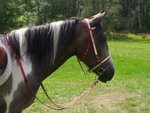1. Exercise your horse daily. This may seem obvious, but it is often overlooked. If you are not riding him for some reason, make sure he is turned out at least part of the day where he can move around freely. This is of utmost importance. Exercise causes better circulation of blood in the hoof, which is a major key to healthy hooves. If you are not able to give your horse turn out time, you can work him on a lunge line or in a round pen. Remember the horse was designed to be almost constantly on the move, covering all different types of terrain. Our practice of keeping them in a stall or small paddock is unnatural, though sometimes necessary, and could be a factor in a number of hoof related problems.
2. Keep your horse's stall or paddock clean. This is especially important if your horse is kept in a small area. Not only does having dirty living quarters make your horse uncomfortable and increase the risk of parasites, it also increases the risk of hoof disease. Areas where manure is left to pile up and compost are breeding grounds for all sorts of bacteria and fungi that can wreak havoc with your horse's feet. Also, be sure your horse has access to high ground where his hooves will have opportunity to dry out. Never keep a horse in a place where he must stand in water or mud for extended periods of time. Again, this may seem basic, but many horse owners do not realize how many hoof and health problems they could avoid by taking a little time to ensure that their horse's living area is properly cared for. Horses appreciate a clean home too!
3.Know your horse's feet. Take time to pick out and handle your horse's feet often. Hooves differ from each other just as horses do. Be aware of what is normal for your horse's feet so you can detect problems early. Some people think it is the farrier's job to clean horse's feet, but it should be done often to avoid thrush and other hoof problems, and to keep your horse comfortable with having his feet handled. Picking out the feet will also remove small stones or other debris that may get caught in the hoof and cause discomfort. It is a good idea to do this before and after riding, or on a daily basis if you are not riding.
4.Trim, trim, trim. Make regular appointments with your farrier, or learn to do your own, (under the guidance of a professional, of course) but keep your horse's hooves trimmed and balanced. This will help you to avoid lameness issues associated with an imbalanced gate. If your horse is shod this may need to be done more frequently, as the hooves are not wearing down on their own at all. Every 6 weeks is standard for shod horses. Barefoot horses vary depending on how hard the hoof is, how much exercise the horse gets, and the type of terrain the hooves are exposed to. Ask your farrier what is appropriate for your horse and situation. We strongly recommend a natural (wild horse) trim, especially for horses with ongoing lameness issues. For more information visit: http://www.barefoothorse.com
5. Be sure your horse has a balanced diet, which includes essential minerals as well as protein, fiber, etc. Many good quality grains include these, but as horse's nutritional needs are not all exactly the same, your horse may need a little extra of a particular nutrient. Silica, calcium, magnesium, and biotin are particularly important for hoof health. Most horses get sufficient amounts of silica and calcium in their regular diets, but sometimes there are deficiencies of magnesium or biotin. Ask your vet for a recommendation if you think your horse may need a supplement.
Thursday, February 22, 2007
Subscribe to:
Post Comments (Atom)



No comments:
Post a Comment